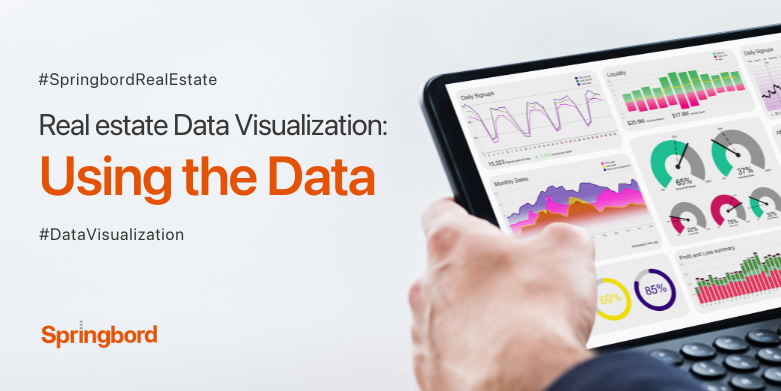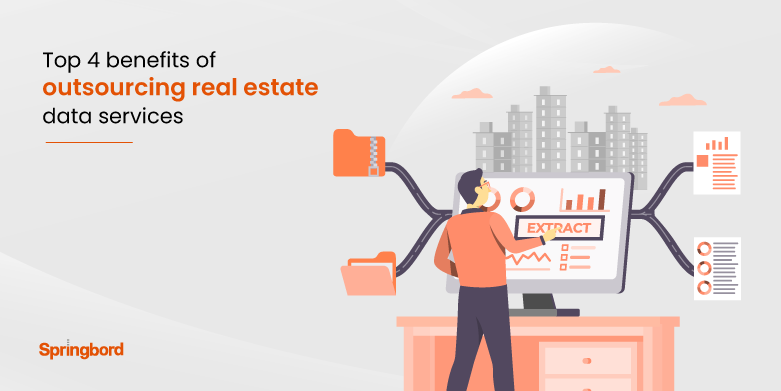 Read time 8 min
Read time 8 minReal estate investment decisions hold immense potential for financial growth but entail considerable risks. Data can be beneficial in this setting for making decisions that optimize returns while minimizing uncertainties.
Real estate investors can gain valuable insights into market trends, risk assessment, and investment opportunities by harnessing the power of data.
This article explores the pivotal role of data in real estate investment decisions, highlighting its ability to enhance analysis, improve risk assessment, and ultimately optimize investment outcomes.
The Role of Data in Real Estate Investment Decisions
Data has become increasingly valuable in many sectors, including real estate, in the modern digital era. Data-driven decision-making involves using relevant data and analytics to inform and guide decision-making. Gathering, analyzing, and interpreting information to make more educated decisions.
Real estate investment decisions are no exception to the benefits of data-driven decision-making. Investors can get a leg up and boost their chances of success by using data to inform their decisions.
A. The types of data relevant to real estate investments:
Regarding real estate investments, several data types are relevant and provide valuable insights. These include:
- Market Data: Market data encompasses information about local housing markets, including property prices, supply and demand dynamics, rental rates, vacancy rates, and market trends. Investors can use this information to grasp the market’s state better and locate promising possibilities.
- Financial Data: The second type is financial data, which includes statistics about a property’s income, expenses, vacancy rate, and cash flow. It’s a tool for gauging a specific investment’s likely returns and dangers.
- Demographic Data: Third, we have demographic information, which may tell us how old the locals are, how much money they make, how many people work in the area, and how fast the population is growing.
Investors can use this information to understand the area’s demographics better and project the residential property market there.
B. How data can enhance investment analysis and risk assessment:
Data is crucial in enhancing real estate investment analysis and risk assessment. Here are some key ways in which data can provide valuable insights:
- Market Analysis: Investors can spot new developments, gain insight into the supply and demand dynamic, and time their investments with precision by evaluating market data.
This enables individuals to make educated decisions in response to market conditions, lowering the probability of making poor bets on a sagging or oversaturated market.
- Property Evaluation: When market and financial data are added to property information, investors can calculate the possible return on investment and weigh the risks associated with a given property.
Investors can determine what a property is worth and use that knowledge to bargain for a better price by looking at recent sales and rental rates in the area.
- Risk Assessment: A thorough risk evaluation is possible with the help of data-driven decision-making by investors. Investors can assess the stability of investment by looking at statistics on vacancy rates, property valuations, and rental income from previous years.
This aids in the development of risk-mitigation strategies and the making of well-informed decisions to safeguard capital.
C. Illustration of the potential impact of data on investment outcomes:
The impact of data on real estate investment outcomes can be significant. By leveraging data-driven decision-making, investors can experience several benefits:
- Improved Accuracy: It increases precision since the information included in the data is trustworthy and reliable. Investment decisions should be founded on facts, not speculation, so investors can minimise risk and maximize return.
- Enhanced Profitability: With data, financiers can zero in on promising investment prospects and maximize their financial gains. Investors can find opportunities, improve negotiations, and increase rental revenue by researching market trends, financial performance, and property data.
- Risk Mitigation: Real estate investors can reduce their exposure to risk by using data analysis to understand better and manage potential problems.
Investors can better protect their funds by evaluating market data, trends, and financial indicators to foresee market swings, evaluate investment risk, and make educated decisions.
Utilizing Historical Data for Investment Insights
Historical data is a powerful resource for real estate investors, providing valuable insights into market trends, cycles, and patterns. By understanding past market dynamics, investors can make informed decisions based on historical patterns, anticipate market shifts, and align their strategies accordingly.
A. Importance of historical data in understanding market trends and cycles:
Historical data is valuable for real estate investors, providing insights into market trends, cycles, and patterns. To make smart investing decisions and accurately predict market moves, you must have a firm grasp of market dynamics.
Investors can learn much about the real estate market’s past performance thanks to historical data, which can be used to spot patterns, volatility, and long-term trends.
By looking at past data, investors can learn about market cycles, including growth, decline, and stability. Investors can use this information to better prepare for market changes, adapt their tactics to the current market climate, and increase their chances of success.
Investors can gain useful insight into the real estate market’s potential in the future by looking at how various factors, such as economic indicators, interest rates, and demographic shifts, have affected it in the past.
B. Methods for gathering and analyzing historical data:
The accuracy and dependability of historical data collection and analysis depend on a methodical approach. Here are some commonly used methods:
- Public Records and Databases: One of the most important places to look for historical information is publicly available records and databases.
This data is readily available from various sources, including government organizations, county record offices, and online databases, allowing investors to keep tabs on property sales prices, previous ownership records, and more.
- Multiple Listing Services (MLS):
MLS platforms used by real estate agents often store historical data on property listings, sales prices, and market activity. Market trends and property performance can be studied in great detail using the data made available by such sites.
- Research Reports and Publications: Research reports and publications provide real estate market history data from various sources, including organizations, research firms, and industry magazines.
Market trends, economic indicators, and performance measurements on a local, national, or international scale are frequently included in these reports.
- Data Aggregators and Analytics Platforms: Data aggregators and analytics suites: a number of these suites focus specifically on the real estate industry.
Property sales, rental rates, occupancy rates, and market indices are only some of the historical data made available by these platforms. Investors are typically given cutting-edge tools and visual representations to aid data analysis and interpretation.
Once the data is gathered, investors employ various analytical methods to derive insights. Methods including statistical analysis, trend analysis, regression modeling, and the visual representation of data fall under this category.
Investors can use these techniques to extract actionable insights from historical data by discovering relevant patterns, correlations, and trends.
Leveraging Market Data for Investment Opportunities
Leveraging market data for investment opportunities is essential to real estate decision-making. By tapping into diverse market data sources and employing various analysis techniques, investors can gain valuable insights into market dynamics, identify promising investment prospects, and optimize their investment strategies.
A. Market data sources and their relevance:
Regarding real estate investment decisions, market data is crucial in identifying lucrative opportunities. Market data is compiled from various sources, such as government documents, property listings, economic statistics, and specialized databases.
Information gathered through these channels is crucial for understanding market dynamics, trends, and the efficiency of individual locations and property kinds.
One key market data source is Multiple Listing Services (MLS), aggregating real estate listings from brokers and agents. The Multiple Listing Service (MLS) provides information on home values, sales history, property characteristics, and community characteristics.
Investors can use this data to analyze the state of the market, evaluate property values, and pinpoint promising development areas.
B. Techniques for analyzing market data to identify investment opportunities:
- Comparative Market Analysis (CMA): A CMA compares the prices of previously sold homes in the same neighborhood to get an idea of the local market’s supply and demand and overall trends. Investors can determine if a property aligns with current market conditions by comparing it to others.
- Absorption Rate Analysis: It is possible to determine how long it will take for the market to absorb the current stock of properties by conducting an absorption rate analysis. A low absorption rate reflects high demand and the possibility of profitable investment conditions.
- Rental Market Analysis: Analyzing rental market data is crucial for investors considering rental properties. Investors can gauge a property’s profitability and future rental income by considering vacancy rates, rental prices, and rental demand.
- Capitalization Rate (Cap Rate) Analysis: Cap rate analysis compares the net operating income of an investment property to its purchase price. This ratio is frequently used to assess rental properties because it provides insight into the property’s prospective return on investment.
Investors can make the most of market data by combining the methods above with their experience and understanding of the real estate sector. Accurate data interpretation, attention to regional market trends, and unity of investment decisions with long-term objectives and risk tolerance are all crucial.
Harnessing Predictive Analytics for Investment Decision-Making
Predictive analytics, a branch of data analytics, utilizes historical and current data to forecast future outcomes and trends. Predictive analytics has become a potent tool for making educated decisions in real estate investments.
By employing complex algorithms and statistical models, predictive analytics can shed light on property prices, market tendencies, and investment returns.
The applications of predictive analytics in real estate investments are manifold. Investment possibilities, risk factors, portfolio performance, and data-driven investment strategies can all benefit from its use.
Predictive analytics can help investors get insight by evaluating hidden patterns, correlations, and trends inside large datasets.
- Examples of predictive models and algorithms used in the real estate industry:
- Automated Valuation Models (AVMs): There are automated valuation models (AVMs) which employ predictive algorithms to assess a property’s value given a variety of inputs such as location, property features, and market trends.
These algorithms may yield property assessments rapidly, allowing investors to evaluate investment opportunities more effectively.
- Machine Learning Algorithms: Real estate predictive analytics heavily uses machine learning methods, including decision trees, random forests, and neural networks. Real estate prices, rental demand, and investment returns can all be accurately predicted by these algorithms by analyzing historical data.
- Time Series Analysis: Time series analysis examines past data and predicts future property values using tools like ARIMA (AutoRegressive Integrated Moving Average) models.
These models consider seasonality, trends, and cyclical patterns, allowing investors to make predictions based on past market behavior.
- Sentiment Analysis: Sentiment analysis is a form of NLP that examines textual data, including social media posts and online reviews, to determine how the general public feels about a given area or type of property. Investors can use this data to gauge market sentiment and make more informed investing decisions.
B. How predictive analytics can assist in forecasting property values and investment returns:
Predictive analytics provides real estate investors with a valuable tool for forecasting property values and investment returns. Predictive models can anticipate future price changes and assess investment profitability by examining historical market data, economic indicators, and property-specific characteristics.
Location, economy, interest rates, and population shifts are just some of the variables these models can consider when estimating property prices. By analyzing these factors, investors can predict whether a property will increase in value over time.
Additionally, using predictive analytics, traders can simulate various scenarios to assess their effect on investment returns. Predictive models can estimate the projected return on investment (ROI) and evaluate the feasibility of a real estate investment opportunity by factoring in rental income, operating expenses, and financing costs.
To Sum Up
Incorporating data-driven approaches into real estate investment decisions is essential for maximizing success in an increasingly competitive market. Investors need access to accurate and timely data on market trends, past performance, and predictive analytics to make lucrative investment decisions.
To better analyze and comprehend data, investors can turn to companies like Springbord, which offers tailored data solutions.
Springbord equips its customers to decrease costs, boost productivity, and fuel growth by leveraging its knowledge and state-of-the-art technology. Real estate investment returns can be significantly enhanced by adopting data-driven decision-making and using the knowledge of organisations like Springbord.







